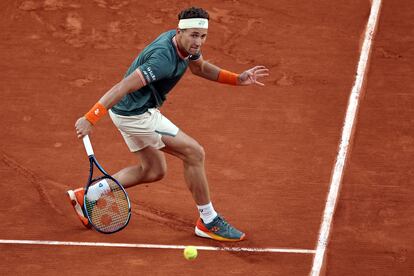Today’s tennis, also on land, is expressed like this, under business logic: minimum investment for maximum benefit. An example is Saturday’s confrontation between Aryna Sabalenka and Paula Badosa, in which only seven of the 118 points settled were debated above nine balls. The rest scrapes and scrapes; 74 of them decided between one and four shots, 37 between five and eight. It happened at the Philippe Chatrier, until not long ago the scene of very long exchanges that little by little are being reduced to pure and simple history. Today, in this modernity, the norms have changed. Stems close to two meters making their way into the terrain of slaters, strategy, effects, angles and high balls.
“As everyone plays in a much straighter way, much more direct and with more power, those changes are being lost. There are very few players who are capable of doing it. There are Nadal or Ruud, but there are not many,” says Jordi Arrese, former Davis Cup captain and silver medalist in Barcelona 92, referring to a crude and increasingly palpable reality: there were the earthlings, the specialists on a surface that, in some way, has ceased to be of interest due to a mere practical issue. Tennis has been covered in cement, the game has been transformed. Of the 72 tournaments that the ATP will organize this year, 42 of them will be on fast, 21 on clay and eight on grass. In the WTA, more of the same: out of 58, 39 will be overly tough.
Today homogeneity rules, the borders between red, green and blue are blurred. A new Muster, a Vilas or a Nadal is impossible; Only the Polish Iga Swiatek follows in the footsteps of Evert, Seles, Arantxa or Henin. “All the surfaces have been very evened out. All players are capable of moving well and competing in all of them. The hard courts have become slower, and the balls are very slow, so you are able to play even at Wimbledon… This is where the circuit is taking us, so that we can all compete on all surfaces,” Pablo tells this newspaper. Carreño. “They are more playable tracks. Before the difference in styles was super marked, but now not so much. It is evolution,” adds Jaume Munar.
The Mallorcan says that he personally likes the challenge of adapting to the floor and the format (covered-uncovered), but admits that the “romanticism of contrasting styles” and a surface that has been losing presence is disappearing. There is the traditional spring stretch – from Monte Carlo to Roland Garros – and the snacks in February (South America) and July (Hamburg, Bastad, Gstaad, Umag…), but the Anglo-Saxon model has ended up overwhelmingly imposed. “There are few tournaments on clay, but with the exception of those on the tour from April to June, the important players are not interested in playing; What interests them is adapting to the fast court, because in the end it is where you play almost all year round and the one that gives you the points,” says Arrese, who at the same time emphasizes that today, even on clay ” goes much more towards the right and the stonethinking little and with little tactics.”
Allergy, serve and an oasis
There are many figures who openly admit that they do not like the sand. In fact, there are some like Daniil Medvedev, who directly says that he does not like to “eat dirt.” Naomi Osaka has never felt comfortable – “I have to learn to slide” – and cerebral players like Casper Ruud or Stefanos Tsitsipas are exceptions in a world where power and minimalism unequivocally prevail; The more speed you can add to the ball and the less wear and tear each point requires, the better. The Austrian Dominic Thiem, who will hang up his racket at the end of the season, is the last pure descendant of a species doomed to extinction.

“It’s true, it’s getting lost,” says Munar. “I think there are still aspects and schools that differentiate some players from others; “You see an Australian or an American, and you compare them with a Spaniard or an Italian, and they are totally different,” he clarifies. Spain, an oasis. Of the 13,534 existing courts in the country, 60% are clay, according to data provided by the Royal Spanish Tennis Federation (RFET); On the contrary, of the 23,000 distributed throughout the United Kingdom, only 1,300 (5.6%) are land.
“The changes in height and the opening of angles have been lost,” laments Arrese, who exemplifies the change in model with two names: Zverev (1.98) and Hurkacz (1.96). “Nowadays, he who takes out rules.” And in parallel, Badosa regrets. “I feel sorry for him, one hundred percent. There are practically no more earthlings. 80% of the year we play on fast and then there is the grass, so you have to play in a specific way and I understand it, because you are not going to change it just for three or four weeks a year,” the Catalan answers to EL PAÍS; “But it makes me sad, because I love the land; It is a very tactical and super-visual tennis for the spectator. It seems different to me, and it makes me sad that we are losing it, especially in women’s tennis. Many play the same here as in rapid. We are going there, to be very aggressive, and I have no choice but to adapt to that.”
A TOUR ABOVE 1.90
AC | Paris
Ben Shelton (Houston): 1.93
Berrettini (Marrakech): 1.96
Hubert Hurkacz (Estoril): 1.96
Stefanos Tsitsipas (Monte Carlo): 1.93
Casper Ruud (Barcelona and Geneva): 1.83
Marton Fucsovics (Bucharest): 1.88
Jan-Lennard Struff (Munich): 1.93
Andrey Rublev (Madrid): 1.88
Alexander Zverev (Rome): 1.98
Giovanni Mpetshi Perricard (Lyon): 2.01
Average height: 1.92.
You can follow The USA Print in Facebook and xor sign up here to receive our weekly newsletter.
_



